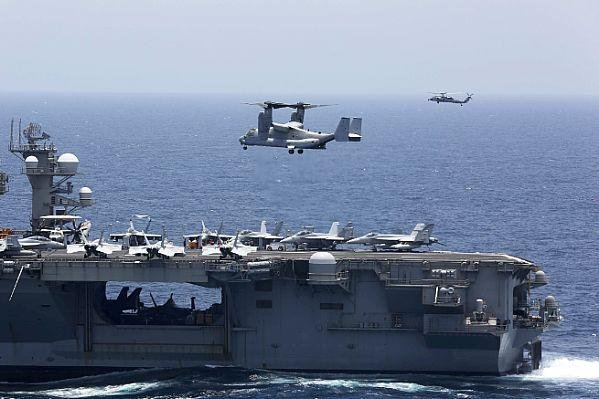1 of 3 | An Osprey helicopter prepares to land on the flight deck of the Nimitz-class aircraft carrier USS Abraham Lincoln on Thursday in the Persian Gulf. Photo by Mass Communication Spec. Seaman Tristan Kyle Labuguen/U.S. Navy
May 20 (UPI) -- The aircraft carrier USS Abraham Lincoln and amphibious assault ship USS Kearsarge conducted joint operations with their strike groups in the Persian gulf last week amid rising tensions with Iran.
The two strike groups, along with the 22nd Marine Expeditionary Unit from Camp Leguene, N.C., worked together on Friday and Saturday as members of the Fifth Fleet, the U.S. Navy said in a news release Sunday.
Last week, the Nimitz-class carrier left the Mediterranean Sea and sailed through the Red Sea to the Gulf of Oman.
The Lincoln strike group was supposed to go to the region but was deployed earlier in response to credible threats from Iran.
"The exercises and training we are doing with Amphibious Squadron Six, the 22nd Marine Expeditionary Unit and USS Kearsarge are aimed towards increasing our lethality and agility to respond to threats, and deterring destabilizing actions in this important region," Rear Adm. John Wade, commander of Carrier Strike Group 12, said in the news release.
The joint training was designed to improve operational tactics in several warfare areas, including air-to-air training, steaming in formation and maneuvering, and establishing joint communications for command and control environment, the Navy said.
Super Hornets from the Abraham Lincoln participated in an air combat training exercise with AV-8B Harriers from the Kearsarge, a Wasp-class amphibious assault ship. The Super Hornets simulated opposing forces, allowing the Harriers a "rare chance to train with a capable and stealthy adversary," according to the Navy.
"I'd never had a chance to train with Harriers before," Lt. Cmdr. Michael Scott, a pilot with Carrier Air Wing 7 operations who led the exercise. "We also had the Harriers receive gas from our airborne F/A-18 mission tanker -- something that rarely happens. It was pretty neat to see the Harrier up close in the air."
Lincoln's Super Hornets, as well as Harriers and attack helicopters from the Kearsarge, conducted a joint close air support exercise, which "provided a unique training opportunity as it joint multiple types of tactical aircraft that do not typically operate together."
The Maritime Raid Force conducted visit, board, search and seizure training, as well as a fast-roping exercise with helicopters and the Arleigh Burke-class guided missile destroyer USS Bainbridge.
CH-53E Super Stallion helicopters from the Kearsarge completed deck landing qualifications on the Lincoln and Bainbridge, and MV-22 Ospreys landed on the Lincoln flight deck.
"This tactical fluency across platforms allows us to efficiently traverse any waters uncontested and readily employ our military assets anywhere, at any time, as demonstrated through this interoperability between Kearsarge and the carrier strike group," said Capt. Jason Rimmer, commanding officer of Kearsarge.
Last week, two Arleigh Burke-class guided-missile destroyers, the USS McFaul and USS Gonzalez, entered the Persian Gulf and will join the Lincoln group. The USS Leyte Gulf, a Ticonderoga-class guided missile cruiser, already is part of the Lincoln group.
The Lincoln, which will transfer to its new home port of San Diego when the current deployment has concluded, replaced the USS John Stennis in the region, and The Kearsarge will be replaced by the USS Boxer, which left San Diego on May 1.
The USS Arlington amphibious transport dock ship and a Patriot surface-to-air missile battery have been moved to the Middle East, as have four B-52 bombers.
Acting Defense Secretary Patrick Shanahan told a Senate Appropriations Defense subcommittee two weeks ago there was "very, very credible" intelligence that Iran was preparing to attack U.S. forces or interests in the region.
The U.S. 5th Fleet area of operations connect the Mediterranean and the Pacific through the western Indian Ocean and three strategic choke points.















